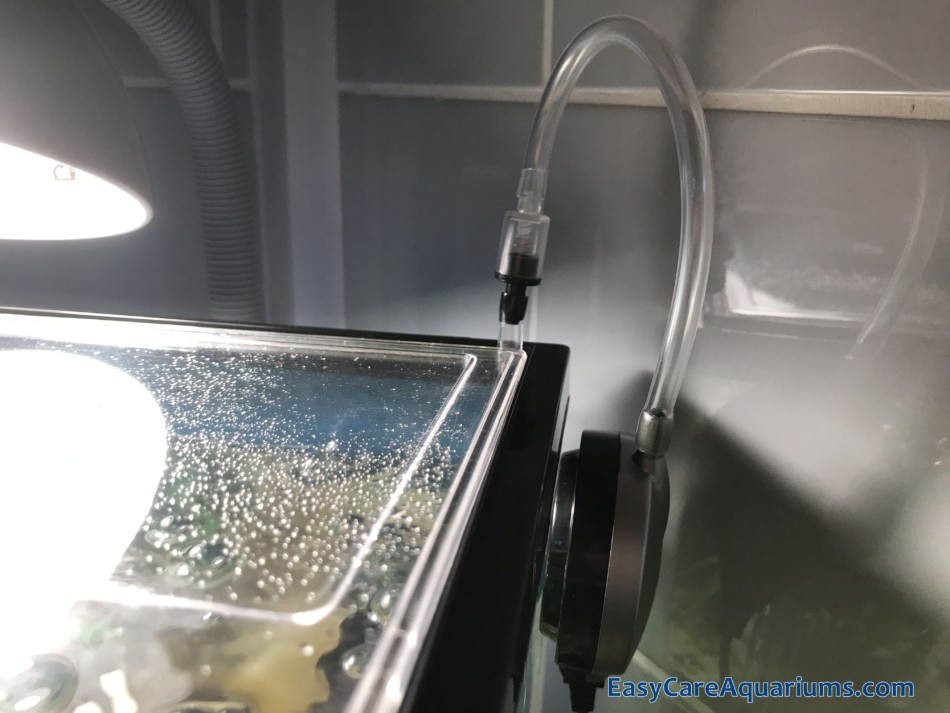This article may contain some affiliate links to products. The links provide me a small percentage of commission but do not cost you anything extra to use. (See full disclosure statement here ).
).
A sponge filter is one of the easiest ways to provide your aquarium with filtration and oxygenation. It’s popular with a lot of fish keepers because of its simplicity, efficiency and low cost.
An aquarium sponge filter consists of a filtering sponge which slides over a central openwork core. On top of the central core is a clip-on disk that has a ‘nipple’ where you attach the air line. There is also a lift tube that the air line is fed through when attaching it to the nipple fitting. Free-standing sponge filters also have a clip-on weighted base to keep the sponge filter down on the tank substrate.
While most sponge filters are cylindrical in shape you can buy corner sponge filters (Amazon Link) like my one in the photo.
(Amazon Link) like my one in the photo.
Sponge filters come in different sizes and filtering capacities too. And there’s also a choice of how fine, or coarse, the sponge is.
Read on to find out how a sponge filter works, and what you need to do to get your sponge filter going.
What Does A Sponge Filter Do?
A sponge filter works by trapping debris from the tank water. It does this by using the suction that’s created in the openwork core when air is forced in through the air line causing the bubbles rise.
Trapping particles of leftover food and other nasties, like floating fish poop, helps to keep the aquarium water clean and clear.
But that’s not the only reason why sponge filters are good for aquariums.
Removing debris is the mechanical side of how a sponge filter works. But sponge filters provide biological filtration too.
Once a sponge filter has been running for a few weeks it begins to provide the tank with biological filtration. The beneficial bacteria that grow on the waste that the sponge has collected helps to create a healthy tank environment for your fish, shrimp and/or snails.
And in addition to the mechanical and biological filtration the constant plume of bubbles provide oxygenation as they agitate and break the surface of the water. They create a gentle flow in the tank too.
So, despite its simple design, low cost and easy maintenance, the aquarium sponge filter is a good choice when it comes to tank filtration.

Does A Sponge Filter Need An Air Pump?
To get your sponge filter to do it’s thing you need to add an air supply. A sponge filter works by using the suction that’s created when air is forced through the central core. Which means that some sort of air pump is going to be an essential piece of equipment.
An air pump and air line is the simplest way of doing this.
Air pumps come in different designs and capacities. You’ll need to choose one that is suitable for the size of your tank and the amount of filtration you’re going to need.
It’s best to get some professional advice on this because some fish are messier than others. Goldfish, for example, poop a lot. So their tank will need more filtration than a less messy fish such as the White Cloud Mountain Minnow.
What is an air pump? And are there other ways to power a sponge filter?
Air Pump – An aquarium air pump is basically a small electrical motor that forces air through an air line tube into your tank. The tubing can be attached to an air stone, tank decoration or an aquarium filter.
Whatever you choose to attach the air pump tubing to it will create bubbles. The bubbles can be purely decorative or used as part of your aquarium filtering system.
For example, I’ve got an air pump attached to an air stone/diffuser in my larger tank. It creates a bubble effect that comes out of the top of a ‘tower ruin’. The tank is actually filtered by the internal filter that came with the tank. I added the air pump because I wanted to create a bubble effect.
Despite being ornamental the bubbles from the tower add to the health of the aquarium. The bubbles increase the flow of the tank water and at the same time they help to keep the tank oxygenated.
But I’ve also got an air pump that runs the sponge filter in my Cherry Shrimp tank.
Even though everything about my Cherry Shrimp tank is Nano in size it works really well. The air pump runs the sponge filter efficiently which keeps the tank water clean. And the bubbles it produces create a gentle flow and keep the water oxygenated.
Powerhead – A powerhead is a water pump that’s designed to be fully submerged in the aquarium. It’s used to circulate the water which creates flow and also oxygenates the tank. It helps the tank filter because it keeps the debris in the water column instead of it sinking to the bottom. Which makes it easier for the filter to remove it.
A powerhead can also be used to run a sponge filter.
A powerhead is probably best used to run a sponge filter in larger tanks, with messier fish that need a bigger filtration capacity.
Powerheads are also popular in marine tanks that need more flow to help reproduce the effect of sea currents for the saltwater inhabitants.
It’s best to get some advice before you attach your sponge filter to a powerhead. That way you can be sure it’s suitable for your aquarium and the fish you are keeping.
An air pump is generally enough to run a sponge filter in the average aquarium, but there’s always exceptions to any rule.
So get some advice, or do some research first, before installing a powerhead to run a sponge filter in your tank.
Tip: If you use an air pump and an air line tube to run your Sponge Filter it’s best to add a Check Valve to the air line. A Check Valve stops the tank water running back up the tubing and into the pump when the power is off for tank maintenance, or during a power cut/outage. It’s also a useful safety measure if you have to position the air pump below the water level of your aquarium.
Does A Sponge Filter Need An Air Stone?
A sponge filter doesn’t need an air stone for it to work properly. It filters the tank effectively because of the way it’s made and the way it does its thing. However, there are reasons why you might want to add an air stone to your sponge filter.
The main reason for adding an air stone to your sponge filter is probably noise reduction.
The big bubbles that come out of the top of the sponge filter lift tube can make a loud bubbling noise that goes on 24/7. Some fish keepers find this annoying. Especially if they have more than one tank bubbling away all day and all night.
Adding an air stone to a piece of air line tubing on the inside of your sponge filter core reduces the bubble size. Reducing the size of the bubbles reduces the volume of the bubble sound. So you end up with a quieter sponge filter.
Not all sponge filters will let you add tubing and an air stone though. Some of them have a solid tube that runs down the middle of the central core from the air inlet ‘nipple’ that clips onto the top of the sponge filter. So there’s nowhere to add any extra tubing. My Nano sponge filter in my Cherry Shrimp tank is like this. But fortunately the whole thing is so small it’s not overly noisy.
If you want the option to add an air stone to your sponge filter make sure that it’s possible to adapt it before you buy it.
Another reason for adding an air stone to the inside of your sponge filter is that smaller bubbles mean increased filtration.
If the bubbles generated by the sponge filter are small the sponge will draw in more waste particles making your sponge filter more efficient. So adding an air stone is a simple way to increase the filtration capacity of your existing sponge filter.
Are Sponge Filters Good For Aquariums?
Most, if not all aquariums, need some sort of filtration. Using a sponge filter is an easy, cheap and efficient way to do it. Sponge filters help to keep the tank water clean, provide a home for beneficial bacteria and also provide oxygen to the tank’s inhabitants.
Sponge filters are great for planted tanks too. Live plants benefit from the filtration, oxygenation and gentle flow that a sponge filter provides. And floating plants won’t get sucked down into the water and be damaged as they can with some other types of filter.
All of this makes the sponge filter a good all-rounder.
As with any other sort of aquarium filter, you need to make sure that the sponge filter you’ve chosen is the right one for your tank. So make sure you’re buying the one best suited to your needs.

